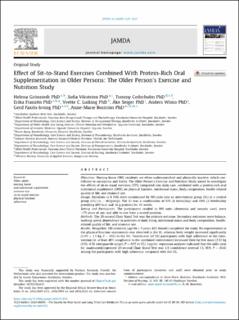| dc.contributor.author | Grönstedt, Helena | |
| dc.contributor.author | Vikström, Sofia | |
| dc.contributor.author | Cederholm, Tommy | |
| dc.contributor.author | Franzén, Erika | |
| dc.contributor.author | Luiking, Yvette C. | |
| dc.contributor.author | Seiger, Åke | |
| dc.contributor.author | Wimo, Anders | |
| dc.contributor.author | Faxen-Irving, Gerd | |
| dc.contributor.author | Bostrøm, Anne-Marie | |
| dc.date.accessioned | 2020-11-30T12:18:01Z | |
| dc.date.available | 2020-11-30T12:18:01Z | |
| dc.date.created | 2020-08-29T12:48:52Z | |
| dc.date.issued | 2020 | |
| dc.identifier.citation | Grönstedt, H., Vikström, S., Cederholm, T., Franzén, E., Luiking, Y. C., Seiger, Å., … Boström, A.-M. (2020). Effect of Sit-to-Stand Exercises Combined With Protein-Rich Oral Supplementation in Older Persons: The Older Person’s Exercise and Nutrition Study. Journal of the American Medical Directors Association, 21(9), 1229–1237. | en_US |
| dc.identifier.issn | 1525-8610 | |
| dc.identifier.uri | https://hdl.handle.net/11250/2690204 | |
| dc.description.abstract | Objectives
Nursing home (NH) residents are often undernourished and physically inactive, which contributes to sarcopenia and frailty. The Older Person's Exercise and Nutrition Study aimed to investigate the effects of sit-to-stand exercises (STS) integrated into daily care, combined with a protein-rich oral nutritional supplement (ONS), on physical function, nutritional status, body composition, health-related quality of life, and resource use.
Design
Residents in 8 NHs were randomized by NH units into an intervention group (IG) or a control group (CG) (n = 60/group). The IG was a combination of STS (4 times/day) and ONS (2 bottles/day providing 600 kcal and 36 g protein) for 12 weeks.
Setting and Participants
The participants resided in NH units (dementia and somatic care), were ≥75 years of age, and able to rise from a seated position.
Methods
The 30-second Chair Stand Test was the primary outcome. Secondary outcomes were balance, walking speed, dependence in activities of daily living, nutritional status and body composition, health-related quality of life, and resource use.
Results
Altogether, 102 residents (age 86 ± 5 years, 62% female) completed the study. No improvement in the physical function assessments was observed in the IG, whereas body weight increased significantly (2.05 ± 3.5 kg, P = .013) vs the CG. Twenty-one (of 52) participants with high adherence to the intervention (ie, at least 40% compliance to the combined intervention) increased their fat free mass (2.12 kg (0.13, 4.26 interquartile range), P = .007 vs CG). Logistic regression analyses indicated that the odds ratio for maintained/improved 30-second Chair Stand Test was 3.5 (confidence interval 1.1, 10.9, P = .034) among the participants with high adherence compared with the CG.
Conclusions/Implications
Twelve-week intervention of daily STS combined with ONS in NH residents did not improve physical function, but increased body weight. Subgroup analyses indicated that high adherence to the combined intervention was associated with maintained or improved physical function and a gain of fat free mass. | en_US |
| dc.language.iso | eng | en_US |
| dc.publisher | Elsevier | en_US |
| dc.rights | Attribution-NonCommercial-NoDerivatives 4.0 Internasjonal | * |
| dc.rights.uri | http://creativecommons.org/licenses/by-nc-nd/4.0/deed.no | * |
| dc.subject | older adults | en_US |
| dc.subject | nursing home | en_US |
| dc.subject | oral nutritional supplement | en_US |
| dc.subject | resource use | en_US |
| dc.subject | sit-to-stand exercise | en_US |
| dc.subject | physical function | en_US |
| dc.subject | adherence | en_US |
| dc.title | Grönstedt, H., Vikström, S., Cederholm, T., Franzén, E., Luiking, Y. C., Seiger, Å., … Boström, A.-M. (2020). Effect of sit-to-stand exercises combined with protein-rich oral supplementation in older persons: The older person’s exercise and nutrition study. Journal of the American Medical Directors Association, 21(9), 1229–1237 | en_US |
| dc.type | Peer reviewed | en_US |
| dc.type | Journal article | en_US |
| dc.description.version | publishedVersion | en_US |
| dc.rights.holder | © 2020 AMDA - The Society for Post-Acute and Long-Term Care Medicine | en_US |
| dc.subject.nsi | VDP::Medisinske Fag: 700::Klinisk medisinske fag: 750::Geriatri: 778 | en_US |
| dc.source.pagenumber | 1229-1237 | en_US |
| dc.source.volume | 22 | en_US |
| dc.source.journal | Journal of the American Medical Directors Association | en_US |
| dc.source.issue | 9 | en_US |
| dc.identifier.doi | 10.1016/j.jamda.2020.03.030 | |
| dc.identifier.cristin | 1825886 | |
| cristin.ispublished | true | |
| cristin.fulltext | original | |
| cristin.qualitycode | 1 | |

